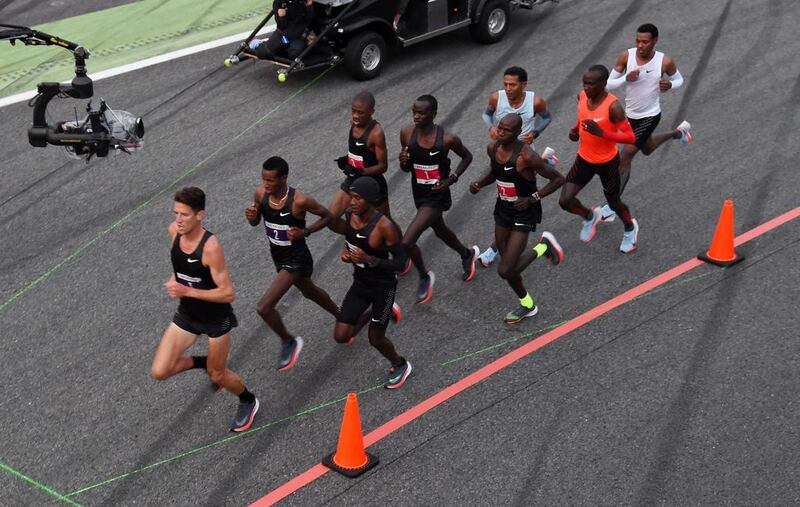MONZA, Italy // It has become one of the question marks hanging over human physical achievement. Like the four-minute mile that went before, athletes are now desperately pursuing the two-hour marathon.
But, so far, that barrier remains unbroken, despite an audacious attempt on Saturday by Olympic champion Eliud Kipchoge.
Backed by a small army of scientists, a rotating battalion of pacesetters and state-of-the-art running shoes, the Kenyan crossed the line on the Monza Formula One track in Italy in two hours and 25 seconds.
His bold attempt to break the two-hour barrier was the quickest recorded marathon but will not enter the record books largely due to the non-compliant system of pacemaking.
The 32-year-old’s time smashed the official mark of 2:02.57 set by fellow Kenyan Dennis Kimetto in Berlin in 2014.
The event’s sponsor, Nike, initially gave the time as 2:00.24 but later revised it up by a second.
“My mind was on under-two hours but in the last two laps I fell 10 seconds behind the pace,” Kipchoge said.
“This journey has been good, it has been hard, it has been seven months hard preparation. It has been history in the world of sport.”
“I am happy to have done it in two hours,” Kipchoge added when asked if he thought sub-two hours was possible.
Kipchoge and the event’s only other competitors, Eritrean Zersenay Tadese and Ethiopian Lelisa Desisaran, ran behind an arrowhead of pacesetters, to reduce drag, and a car beaming a green line on the road behind it to show the required speed for the sub-two hours target.
Amid deep scepticism, Nike pitched the attempt as sport’s “moon shot”, with a keen eye on sales of its running shoes. It designed a lightweight shoe, Zoom Vaporfly Elite, with carbon-fibre in-sole as part of the meticulous preparations.
Nike’s arch rival, German firm Adidas, also has its own ‘Sub2’ project, also with a new shoe.
In 2014, Runners World magazine predicted a sub-two under normal race conditions would not happen until 2075, based on analysis of more than 10,000 top marathon performances.
The race began in pre-dawn gloom at a brutal pace around the Monza track, which was chosen for its wide, sweeping curves, lack of undulation and cool, low-wind environment.
Despite narrowly missing the mark, Kipchoge said he believed it was possible and that he could make another attempt.
In his pursuit of sporting immortality Kipchoge had to set a ferocious pace of 4 minutes 34 seconds per mile — seven seconds quicker than the world record pace set by Kimetto at the 2014 Berlin Marathon.
Requiring the sort of evolutionary leap against the clock that is usually only achieved over decades, Kipchoge started in promising fashion.
Despite being one second over the target time after five kilometres, he was clocked at five seconds under after 10 then 15km and was still two seconds inside the target at the 25km mark.
But over the remaining third of the race Kipchoge steadily began to fall behind pace.
The Breaking2 project was held on the 63rd anniversary of Roger Bannister breaking the four-minute mile in 1954.
“I’ve been part of many races over my career at Nike. I’ve seen the magic of gold shoes and swift suits. I’ve seen iconic athletes leave it all on the track,” Nike CEO Mark Parker said. “But I’ve never seen anything like what we saw today.
“Today, millions of people around the world watched as running history was written.”
*Reuters and Associated Press





